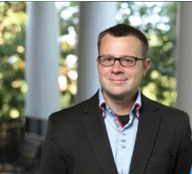
Chris Paolucci, University of Virginia
Using Computational Modeling to Address Stability Challenges for Zeolite Catalysts
Abstract:
My research group uses molecular simulations and mathematical modeling to understand the fundamentals of catalyst stability. These include catalyst synthesis, dynamic changes in surface structure under reaction conditions, and deactivation. In this seminar I discuss two relevant examples focused on catalyst stability: active site selective poisoning of commercial Cu zeolite catalysts, and catalyst deactivation and regeneration by the interconversion between Pd cations and nanoparticles supported on zeolites.
Metal active sites exchanged in zeolites dynamically change speciation under different reaction conditions, resulting in condition-dependent reactivity with gas molecules. This is of particular significance in chemical deactivation, such as sulfur poisoning of Cu-zeolites used for NH3-assisted selective catalytic reduction (SCR) of NOx in diesel engine exhaust. Here, we employ computational techniques, combined with experiments and spectroscopy, to develop thermodynamic models for sulfur poisoning of zeolite framework-bound Cu dimers that form at high temperatures in Cu-zeolites as a function of both the Al distribution and reaction conditions. Our results demonstrate that framework-bound Cu dimers that form under high temperature oxidative conditions are particularly susceptible to poisoning by SO2 and SO3. These Cu dimers react more exothermically with SOx species than Cu monomers, forming thermodynamically stable sulfur-containing Cu dimers that require high temperature (> 870 K) desulfation treatments for sulfur release and, therefore, catalyst regeneration.
Next, we apply similar computational machinery to Pd cations and nanoparticles supported on zeolites, which are used as catalysts for a wide range of chemical reactions, with various and distinct active site requirements. Therefore, sintering and redispersion processes that interconvert cations and nanoparticles underpin activation and deactivation of these catalysts, yet the influence of the nanoparticle size distribution, gas conditions, zeolite topology, and cation identity on the thermodynamic and kinetic factors influencing such interconversions are not well-understood. We use a combination of computational analyses and experimental validation to determine the conditions that generate a favorable thermodynamic driving force for agglomeration or redispersion and use kinetic Monte Carlo simulations to estimate interconversion rates. We show that water, a ubiquitous molecule in practical applications of these materials, promotes agglomeration of cations into nanoparticles, even under high-temperature oxidizing conditions.
Bio:
Christopher Paolucci joined the Department of Chemical Engineering at the University of Virginia in Fall 2018 and was promoted to Associate Professor in 2024. He received his BS in Chemical Engineering from the University of Notre Dame in 2012, and his PhD in Chemical Engineering from the University of Notre Dame in 2017 under the guidance of William F. Schneider (2012-2017) and as a visiting scholar at Purdue University under the guidance of Fabio Ribeiro, Nicholas Delgass, and Rajamani Gounder (2015). He continued his research in machine learning guided materials screening between fall 2017 and spring 2018 in the group of Jens Nørskov and Thomas Bligaard at Stanford University. Chris’ expertise is the application of electronic structure calculations, molecular dynamics, Monte Carlo simulation, and kinetic modeling to problems in materials science and heterogeneous catalysis. His main research areas of interest are catalyst stability and catalyst dynamics under reaction conditions. He received the ACS PRF Doctoral New Investigator award in 2021 and the NSF CAREER award in 2022. He served as a director of the Catalysis and Reaction Engineering Division of AIChE from 2019-2021, was the president of the Southeastern Catalysis Society in 2023-2024, and currently serves as the fall programming chair for the ACS Catalysis Division